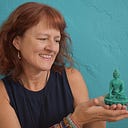There Is No Death
I learned of Thich Nhat Hanh’s death yesterday thanks to a dear friend calling to console me, not realizing that she was, in fact, informing me.
I never had the great honor of being in Thich Nhat Hanh’s physical presence though I was fortunate in attending a retreat at his monastery Magnolia Grove, located in Mississippi. Less than a year before my retreat, Thich Nhat Hanh had a stroke, making it impossible for him to be part of the retreat.
Rather than referring to him as Thich Nhat Hanh, his monastics and those who had attended multiple retreats and met him, called him Thay, which means teacher.
Though I didn’t meet him, I feel as if Thay was my teacher also. Early in my quest to find ways to deal with my anxiety and difficult life circumstances that included divorce and my mother’s dementia, I discovered Thay’s books and online dharma talks.
His teachings went on to influence the writing of my own book, where I found myself referring to him more than any other Buddhist teacher.
Yet, surprisingly to myself, I didn’t need consolation from my friend, which is the best compliment I can give to Thay as a teacher. I knew his teachings on death, and they allowed me to process Thay’s own death without suffering.
Because Thay wasn’t present at my retreat in 2015, various speakers took the lead, with dharma talks from his monastics and past retreat participants.
Since learning of Thay’s death, I keep flashing back to one talk given by an older woman who directly addressed Thay’s absence. She radiated positive energy and spoke with an authentic smile that matched a lilt in her voice when describing a conversation she had in the past with Thay about death. She explained, with almost a tiny dance-like kick, that she wasn’t afraid of death because Thay had explained there was no such thing. This was absolute truth for her.
Neither she nor I (nor Thich Nhat Hanh) are arguing that the physical bodies we inhabit give out and are no more. However, the teaching is that because there is no self, there is no death.
Thay liked to use the example of a tree. When looking at a tree, we never can find an essential element that is the one thing that makes a tree a tree. Rather, like all physical phenomena, the tree is an amalgamation. It is limbs, roots, trunk, leaves, soil, clouds, sun, and, if planted, also consists of the labor of the person who planted it.
It’s the same for people. There is no single part of a person that we can point to as the self. We are an amalgamation of our ancestors, our body, our thoughts, our feelings, our culture, etc., so there is no essential self that dies.
Thay explained that he would not die because all of his monastics would be his continuation. His teachings would be his continuation.
All of us who call him Thay are his continuation.
In Harry Potter and the Deathly Hallows, J.K. Rowling includes a parable where Death is personified. Three brothers meet him on their journey when they reach a dangerous river and use magic to cross it. Death appears, having expected them to die. Feeling cheated, he tricks the brothers into making requests for gifts that he believes will hasten their deaths, giving him his due. Death’s manipulation works on two of the three brothers. However, the “humblest” and “wisest” of the three sees the trick and asks for an invisibility cloak unlike the two brothers who want power of some kind.
The third brother goes on to have a family and live a long life. Having “attained a great age,” he gives the cloak to his son. “And then he greeted Death as an old friend, and went with him gladly.”
When Thay’s monastery in France, Plum Village, announced his death, the notice said that he had passed away peacefully, a common description in a death announcement, but, in this case, I feel confident that it is true and that Thay greeted Death as an old friend.
I am equally confident that Thay lives on.
